-
Lee chang-dong: Secret sunshine (2007)
LEE CHANG-DONG: SECRET SUNSHINE (2007)

JEON DO-YEON
A new life gone terribly wrong
The most interesting thing about Miryang (Secret Sunshine) is the actors. Jeon Do-yeon, as Lee Shin-ae, the main character, is a woman with a young son whose husband has died in a tragic accident, and who leaves Seoul to live in Miryang, which was his home town, with her young son. Jeon’s face is very changeable. She is girlish, flirtatious, elegant, aged and sad, desperate and joyous, with it and terribly isolated by turns, and it’s all in her face. The film also stars Song Kang-ho as Kim, a man who meets her when her car breaks down coming into Miryang, who happens to run a garage in town, and who follows her around all the time thereafter, despite her apparent lack of interest in his attentions. Song is the biggest star in Korea right now, renowned for his work with Park Chan-wook and Bong Joon-ho (Sympathy for Mr. Vengeance; Memories of Murder and The Host). And yet here he plays a throwaway character, almost a forgotten man. But of course he makes him interesting and curiously appealing. He is the essential ballast to keep Jeon’s character from floating away.
Lee Shin-ae is a piano teacher. She comes to the new town, which is a neutral place, a kind of poor-man’s Seoul, a town "just like anywhere else," as Kim says (just as he is in a way just like anyone else). Her little boy is sprightly, as little boys are, but plainly damaged and withdrawn at times too. His father used to snore, and when he misses him he lies awake, pretending to snore. He goes to school, and Shin-ae meets parents and students and shopkeepers. There is a sense of place in the film, even though the place is in a sense "anywhere." People speak in the local dialect, and everyone knows everything, and Shin-ae’s Seoul origin is immediately noticed. Is life really harsher here, away from the big city and its sophistication? Shin-ae seems not to realize the danger she is in.
Something terrible happens. And Shin-ae doesn’t necessarily deal with it in the best possible way. But it happens and she must face the consequences. But she can’t. She goes to pieces. A perpetrator is caught, but that’s no consolation. Eventually she becomes so despairing, she relents and goes to a born-again Christian meeting an acquaintance has been pressing her to attend. She finds peace and release with this. But when she decides not only to forgive the perpetrator but to go to the prison to tell him so, that experience is full of ironies and it destroys her all over again. She becomes embittered and desperate and she no longer finds solace in religion. And it gets worse than that.
Jeon Do-yeon gives her all in this extremely demanding and protean role. Lee Chang-dong may be a very good director. If an actor of the stature of Song Kang-ho expresses enormous admiration for him, that is convincing. According to Scott Foundas of LA Weekly, Lee’s first three films, Green Fis (1997), Peppermint Candy (2000) and Oasis (2002) have marked him out as "one of the leading figures of his country’s recent cinematic renaissance." But this is not as successful a film as those of other Korean directors whose work I’ve seen, such as Yong Sang-Soo, Bong Joon-ho, and the prodigiously, almost perversely gifted Park Chan-wook. It may indeed begin as Foundas says as a kind of "Asiatic Alice Doesn’t Live Here Anymore" and then "abruptly and without warning" turns into "something of a thriller, and some time after that a nearly Bressonian study in human suffering." But that progression not only seems random and indigestible; the film sags and loses its momentum toward the end and then simply fizzles out, with no sense of an ending. There are also weaknesses in the action. Shin-ae takes foolish chances with her son, and makes bad choices all along. If she is destined for madness like Betty in Jean-Jacques Beineix's Betty Blue, which might explain her peculiar and mistaken choices, that isn’t something that is properly developed. This is an interesting film, certainly a disturbing one, but one that leaves one doubtful and dissatisfied, after putting one through an emotional wringer.
An official selection of the New York Film Festival presented at Lincoln Center, 2007—an event that has done right by Korean filmmakers in the recent past.
Last edited by Chris Knipp; 08-08-2014 at 08:07 PM.
-
Juan antonio bayona: The orphanage (2007)
JUAN ANTONIO BAYONA: THE ORPHANAGE (2007)
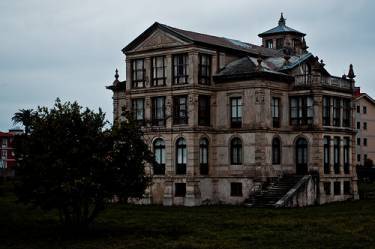
Uneasy beginnings
Juan Antonio Bayona's first film has the formidable sponsorship of Guillermo del Toro. He's also found US distribution for it by Picturehouse, who handled his celebrated Pan's Labyrinth. The latter shares certain elements with the screenplay by Sergio G. Sanchez, another first-timer. It concerns a couple living in a former orphanage whose adopted seven-year-old tragically disappears, causing the mother to resort to mediums and seances and seek communion with the dead through reliving her own hidden past. Del Toro not only produced The Orphanage, he has chosen to personally promote the film. And since it is a premiere effort for much of the filmmaking team (except the actors), its polish is impressive; moreover the story is a sophisticated one. But both story and treatment wind up being little more than a high class horror movie--without the gore of the current crop, but with a lot of loud sound effects designed to jerk you out of your socks--not to mention the usual crumbling corpses, hideous masks, and doors suddenly shut behind innocent victims. One step forward for some young filmmakers in Spain; but another step backward--and no competition, needless to say, for Pan's Labyrinth. This is another sign of FSLC and New York Film Festival director Richard Pena's admirable support of Spanish language films, but it is not the brightest gem in the festival's crown this year.
An opening flashback shows young Laura playing with five companions at an orphanage in a big old house thirty years ago, just before Laura is to be adopted. Flash forward, and a 37-year-old Laura (Belen Rueda) and her husband Carlos (Fernando Cayo) with seven-year-old son Simon have moved back into the very same old orphanage, unused now, preparing to renovate it to house a small number of mentally and physically handicapped children.
Simon (Roger Princep) seems uneasy in the new location. He doesn't sleep well, and has dreamed up some imaginary friends. Various signs suggest he's somehow connecting with Laura's childhood. Once a scary fake social worker (Montserrat Carulla)--an old lady with thick glasses--works her way briefly into the house to give Laura a threatening interview, things turn permanently bad. Simon mysteriously is led to find out two things about himself Laura and Carlos weren't going to tell him till later: he's adopted, and he's HIV-positive. During an initial reception for the new home, Simon refuses to come downstairs, and shortly later he disappears. This reception sequence seemed to me the most creepy and memorable of the film, its use of handicapped children in scary masks eerily reminiscent of the photographs of Diane Arbus.
Laura carries out a desperate and hopeless search for the missing boy. After six months she arranges through a specialist in parapsychology to have a medium, Aurora (Geraldine Chaplin) come to the house with a team of observers. The result of this episode, which involves night-vision imaging, TV monitors, and other tech devices, is that Aurora thinks Simon is somehow connected now with the orphans who lived in the building thirty years ago--Laura's contemporaries and pals. Actually, we knew that; the elaborate business is absorbing, and Chaplin delivers a stark, haunting turn, but it adds nothing new and from here on in some sense the screenplay gets tangled in its own complications.
Earlier discussions with Simon about Peter Pan (he announces he's never going to grow up) introduced themes of regression and eternal childhood. They flow in and out of the film hereafter. Carlos is of the opinion that the former orphanage has bad vibes and they need to leave, or at least take a break from being there. But Laura refuses to go, so Carlos leaves her by herself. Thereafter things get very complicated and the screen belongs to Rueda, whose emotional intensity and sensitive face carry us through a series of sequences involving reenactments of childhood games and other physical experiments by Laura to communicate with her pals from the past and find out what happened to Simon. The film flows in and out of reality and sanity and, frankly, lost me at some point here, so that whether the ending is satisfying or not isn't something I'm prepared to say.
Thematically this is an interesting screenplay, but the use of very conventional, if slick, horror film shock devices would tend to alienate the fan of straightforward drama. Pan's Labyrinth, with its richer canvas and constant shifts back and forth from a child's fantasy (or supernatural) world to a grim present political reality provide a far more satisfying and complex experience. Excellent performance by Belen (who previously co-starred in The Sea Inside), and a promising debut for Bayona, Sanchez, and their team. The sound design is effective, but over-the-top.
Last edited by Chris Knipp; 08-08-2014 at 08:11 PM.
-
Bela tarr: The man from london (2007)
BELA TARR: THE MAN FROM LONDON(2007)
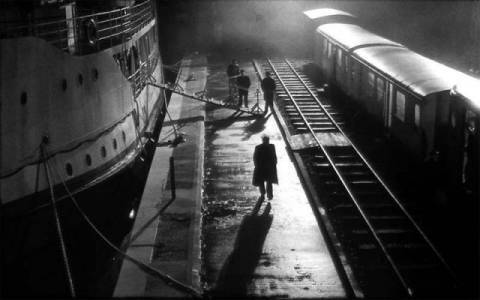
Image over matter
This selection of the New York Film Festival 2007 may be a fair introduction to the style of the critically celebrated Hungarian auteur, but its handling of an obscure Georges Simonon crime novel is a disappointment. Details that would make the story compelling in genre terms are dropped without the gain of existential dread the filmmaker seems to have had in mind. The richly textured black and white visuals are a pleasure, but the super-measured pace seems out of synch with a narrative of crime, furtive involvement, and investigation. Experts on the director say this isn't his best and that's a relief to know. Testimonials from Gus Van Sant, Jim Jarmusch, and the late Susan Sontag would lead one to expect much more. Despite beautiful imagery, this provides longeurs, not transcendence.
A man works nights at the switch station of a dock-to-tracks port outlet. It’s somewhere in France. Since everybody speaks Hungarian, two of the main actors are Czech and Scottish, and a couple of the main characters have English names, you might not pick up on that till later. Nearly all of the shots of this location are from the stationmaster's elevated observation point, thus providing misty panoramas reminiscent of early modernist photography (Moholy Nagy’s for example), and they are the most beautiful images in the film. DP Fred Kelemen does not disappoint. Mihaly Vig's mournful score accompanies an excruciatingly slow series of opening up and down pans. Those who've heard Tarr is a terrible bore don't have to wait long to have their point proven for them—but the aesthetics keep you watching.
Despite its maddening abstractness, in a way this is the most memorable part of the film. It also sets up the main event—which is that on this night when the ship lets off its passengers to mount a train, the signal man sees an attaché case thrown off the boat to a man waiting across the way on a cement platform. When he has the case in hand, another man comes by and tries to get it from him. In the intense struggle that ensues—all seen still only from a distance—the receiver of the case is knocked in the water with the case, and apparently drowns; the other man disappears. After boat and train have departed, Maloin (Miroslav Krobot, a Czech actor)—we learn later that’s the signalman's name—retrieves the case from the water and finds it full of English pound notes, which he dries off little by little on his stove up above.
Maloin, whose viewpoint the film adheres to faithfully much of the time, to the extent of the camera's being right over his shoulder more than once, is that regular in Simenon stories, a dreary Everyman who thinks a stroke of luck will alter his life but gradually learns otherwise. The same basic premise of an innocent falling upon a criminal’s treasure trove of cash inheriting nothing but trouble—will soon be seen at the festival, and before long by everyone else, in the Coen brothers' No Country for Old Men. In Cormac McCarthy’s story, which is full of flash and suspense, dangerous men soon come after the finder. Maloin’s fate is much less dramatic. He takes his daughter Henriette (Erika Bok) out of her crummy job at an epicerie-butcher shop and buys her a nice fur neckpiece. She’s not a good looker, and she closely resembles her mom, a voice-dubbed Tilda Swinton, who’s crabby and disapproving. Obviously he can’t tell them anything. For a while nothing happens. Then a police Inspector Morrison (Istvan Lenart) arrives from London, because the money was stolen: £60,000 was seized by a certain Brown (Janos Derzi), and the drowned man was his accomplice, Teddy. Morrison explains everything and thus fills in the details of the original plot. The actual outcome, even after Maloin has committed a crime, turns out to be surprisingly mild.
The director has written as follows about the plot: "when Maloin witnesses a murder, his life changes. He has to confront the moral questions of what constitutes crime and punishment, where to draw the line between innocence and complicity in crime[;] skepticism leads him to questioning the very meaning and worth of existence…" All this doubtless ought to happen, but unfortunately in the movie Tarr made it doesn't. There are some mournfully droll scenes in the hotel bar where everybody meets. We follow Maloin plodding around the port and confronting his family. But these great moral confrontations do not take place for us, or, on the evidence, for the protagonist.
Certainly there’s a very distinctive style here. But perhaps due to production problems causing the film to take four years to complete—the most notable interruption was the suicide of the famous indie producer Humbert Balsam in 2005—the flow is rather halting, and I don’t just mean slow (the running time is 135 minutes).
The Georges Simenon novel was previously made into a movie by the French director Henri Decoin in 1943.
An official selection of the New York Film Festival at Lincoln Center, 2007.
Last edited by Chris Knipp; 08-08-2014 at 08:12 PM.
-
Gus van sant: Paranoid park (2007)
GUS VAN SANT: PARANOID PARK (2007)

GABE NEVINS
The film publicity lays it out about Paranoid Park with a synopsis that goes like this:
Alex, a teenage skateboarder, accidentally kills a security guard in the vicinity of Paranoid Park, Portland’s tough skate park.
He decides to say nothing.
That is indeed what happens, and in action terms all that happens, so you could call this a police non-procedural. The story is not told in the simple order suggested by the synopsis. It’s only gradually that the audience learns what Alex (Gabe Nevins) has gotten involved in, and as the synopsis says, he never tells anybody (though viewers get to see it). He alludes vaguely to something bad that’s happened when talking to Macy (Lauren McKinney), a smart, ironic girl who seems to move in on Alex as Jennifer (Taylor Momsen), who wants to be his girlfriend, moves out (he breaks up with Jennifer after they’ve had sex). Macy suggests that to get it off his chest Alex can write a letter or diary about whatever happened—then, if he likes, just burn it. Through following Alex’s various writing sessions, Van Sant weaves in the story of that event he can’t talk about, doesn’t know what to do about, and can’t stop thinking about.
His best friend Jared (Jake Miller) thinks Alex is crazy to give up “free sex” by breaking up with Jennifer; but he does. Maybe what has happened to Alex puts having sex into perspective for him But even before that going to Paranoid Park with Jared was more interesting to Alex at this stage than Jennifer. Paranoid Park is an awesome place to skateboard. It’s also scary: scary because it’s a bad part of town, and there are tough older guys who hang out there; and also challenging for Alex because he doesn’t think he’s good enough to skate in public. But it calls to him even when Jared can’t go there with him. He goes alone one night, and that’s when he talks to some of the older guys and afterwards the bad stuff happens.
The story about the death of the security guard by the railroad tracks comes up on the TV news. It looked accidental, but then a possibility of homicide appeared. Because the train tracks where the death occurred are near Paranoid Park, Detective Richard Lu (Dan Liu) shows up at Alex’s high school and all the skateboarders are summoned to talk to him. He interviews Alex separately later (but that’s seen before). Detective Lu is very good at talking to the boys. He’s completely non-threatening, but he does his job. However, it seems likely that as one kid says, he’s just being a cop, but doesn’t really know anything. Anyway, this story isn’t about the crime investigation; it’s just about Alex.
Alex’s and his little brother’s father has moved out and their parents are getting divorced, not an easy thing to deal with. What’s most important in Alex’s life right now? His involvement in accidental homicide? His parents’ divorce? A girl who wants to have sex with him before he’s ready? Paranoid Park—a test of skateboarding manhood? The movie shows all these things competing for attention in Alex’s world.
Teenage boys tend to be somewhat opaque. The movie is true to that. Certainly Alex never shows others any sign of anxiety. He’s cool as a cucumber, but without being hard. (His face is gentle, almost pretty.) He’s simply a teenage boy. Van Sant, working from Blake Nelson’s novel, set in Portland like the film, gets that right. Some of the dialogue is hilariously authentic teenage talk. And after Jennifer and Alex have had sex, she is immediately offscreen on her cell phone to her best girlfriend saying, "We did it, we totally did it. It was awesome!" You could laugh so hard you’d cry. But the movie creeps up on you, it’s so understated. There is a lot of use of music. When Alex drives his mother’s car to the skate park alone that evening (he looks like a child behind the wheel) different music plays from rap to Beethoven’s Ninth, and Alex’s expressions change with each change of sound as if to express a boy’s sudden shifts of mood.
Paranoid Park has a gruesome moment, but as should be clear by now, it’s generally notable for its subtlety and restraint (as was even Elephant, considering).
Van Sant follows the format of his last three films, Gerry, Elephant, and Last Day, and draws his actors mostly from Portland high schools as he did for Elephant. This time the cinematography is by Christopher Doyle. Doyle is associated with the blurry kinetic effects in Wong Kar Wai films, but he’s worked with static shots, and with other directors. His skill pays off in beautiful visuals throughout, the gift for flowing movement shown in the recurrent skateboarding sequences--which don’t go so much for showy runs as for cool, idiosyncratic moments.
Despite shifts in subject matter and DP, Van Sant’s last four films are notable for consistency and quality and a return to his indie roots. This is more interior as a psychological study (cryptic though it may be) than the other films—and less attention-getting too. Gerry (but has anyone seen it?) is notable for its amazing real-time effects as it explores the horror of getting lost in the desert. Elephant leads up to a Columbine-style school massacre and is the opposite of Paranoid Park, because it’s a multi-viewpoint event film. Last Days is a dreamy mood piece about a doomed rock star fading into isolation and madness, a la Kurt Cobain. Paranoid Park has a terrible event at its center too, but approaches it crab-wise. It’s all in the style. The film could be a TV movie-of-the-week, perhaps, with a breathless moralistic finale. Van Sant’s distinctive touch is both in the elegantly offhand tale-telling and in the quiet finish. In a sense it’s a movie about forgiveness.
Last edited by Chris Knipp; 11-30-2022 at 10:40 AM.
-
Todd haynes: I'm not there (2007)
TODD HAYNES: I'M NOT THERE (2007)
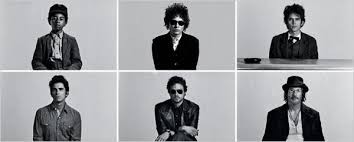
A film biography almost as complex as its subject
Haynes’ adventurous biopic of Bob Dylan, which uses six actors of both sexes and several races ranging in ages from 11 to 50, is both exhausting and fun to watch. It’s also hard to describe. But let’s start with those six and the characters or facets they portray. Arthur (Ben Whishaw) is the Dylan who incarnated Rimbaud and serves as a kind of narrator whom we see smoking and giving ironic answers to some kind of inquisition sporadically throughout the film. Woody (the wonderful young Marcus Carl Franklin, an amazing a singer and actor) is a precocious rail-hopper with a guitar (labeled like the real Woody’s, THIS MACHINE KILLS FASCISTS) and tall tales that start with his claim that he’s Woody Guthrie. Woody’s scenes show him rescued by a black family and a white family and performing with country black musicals. He represents the early shape-shifting Dylan in search of an identity and telling a lot of lies along the way.
Jack (Christian Bale) is the Dylan who became a hit in Greenwich Village and went into the South and sang “The Ballad of Hattie Carroll” and other protest “folk songs,”—the high-profile “political” Dylan who spearheaded a movement and became famous with his brilliant early LP’s. But Jack doesn’t want to be typecast and “betrays” his adoring public and his lover and folksinging champion Alice (Julianne Moore), a Joan Baez stand-in seen in later “interviews.”
Jack disappears and his place is taken by Robbie (Heath Ledger), a young actor in New York who becomes famous for starring in a 1965 film depicting the vanished Jack. Robbie meets Claire (Charlotte Gainsbourg) in a Village coffee shop and falls in love, and a turbulent ten-year marriage follows, winding up painfully at the time of the Vietnam War’s end.
If Jack represents the cast-off early style and Robbie represents Dylan’s family life, Jude (Cate Blanchett) is Dylan the artist, quintessentially as seen in the mid-to-late Sixties when he toured England (an event notably chronicled by two Leacock-Pennebaker documentaries)—and shocked his audiences, some of whose members felt betrayed and shouted “Judas!”, when he shifted from solo guitar and harmonica to more personal songs with loud rock accompaniment. Jude’s segments are partly borrowed from Pennebaker, but largely consist of gorgeous black and white scenes deliberately and “churlishly” (Haynes’ word) imitative of Fellini’s 8 ½.
Jude’s new style is admired by Allen Ginsberg (David Cross) and underground groupie Coco Rivington (Michelle Williams) and he becomes internationally famous. But he continues to be misunderstood by the protest music old guard and conventional journalists like the British TV host Mr. Jones (Bruce Greenwood)—who’s incorporated into a music video for Highway 61 Revisited's "Ballad of a Thin Man":
. . .something is happening here
And you don't know what it is, do you, Mister Jones. . .
He’s reborn symbolically in Pastor John (Christian Bale again), who’s moved to Stockton twenty years later and become a born-again preacher, singing his own gospel songs. Finally the last version of Dylan appears in Billy (Richard Gere), in full retreat from the world—till threats to destroy his town of Riddle cause him to enter public life again. This sequence evokes a Sixties historical western in which Pat Garrett (Bruce Greenwood) is a character.
This is only the barest outline of the two-and-a-quarter-hour film, in which various “Dylan’s” are woven in and out. Maybe the reason why I found Woody’s sequences delightful and Billy’s colorful but wearying has to do with the latter’s coming two hours later. But Gere and his sequences evoke Dylan less well and are puzzling to interpret. Blanchett’s in contrast are, of course, the most conventionally straightforward. She’s the only one who successfully mimics the physical appearance and the speaking voice of the artist (unless Whishaw does a better job with the voice). But Blanchett’s mimicry is intentionally undercut (and the biopic conventionality of films like Ray avoided) by having Jude be played by a woman—which was planned by Haynes in his screenplay before he even chose his actor.
The method Haynes has chosen avoids cliché. This is still a biopic, but it’s a sophisticated one; and the fractured portrait is well justified by the nature of its subject. Dylan has always been a shape-shifter; some of his permutations were left out, such as the period of the orthodox Jew and JDL supporter. But it’s intelligent to see Dylan the man, the husband, the artist, the political being, and the religious being as completely separate entities because no simple biopic sequence can really dramatize the complexity of such an artist and such a protean existence. Haynes’ film makes you think about biography itself, as well as giving imaginative shape to aspects of Bob Dylan no non-fiction account can really provide.
You have to get your head around the fact that there’s an experimental methodology at work here. Maybe that’s the reason Dylan himself, approached through his eldest son Jesse, agreed through his long-time manager Jeff Rosen to grant Haynes both the musical rights and the biographical rights. Haynes has chosen a multifaceted and original way of using Dylan’s songs. Only Franklin actually performs them with his own voice. Otherwise the soundtrack mixes original Dylan recordings with existing covers, new ones by people as widely various as Ritche Havens, Iggy Pop, John Doe and Sonic Youth, and other music, including, appropriately for the 8 ½- esque sequences, Nino Rota. There is a voiceover narration by Kris Kristofferson. Haynes worked on the screenplay for years, and then collaborated with Oren Moverman.
Shown in the press screenings of the New York Film Festival at Lincoln Center 2007. Haynes was present fort a Q&A afterward with J. Hoberman of the Village Voice, which revealed that the director is an intelligent and articulate man and who knows his Dylan inside and out.
Last edited by Chris Knipp; 06-16-2017 at 07:25 PM.
-
Jose luis guerin: In the city of sylvia (2007)
JOSE LUIS GUERIN: IN THE CITY OF SYLVIA
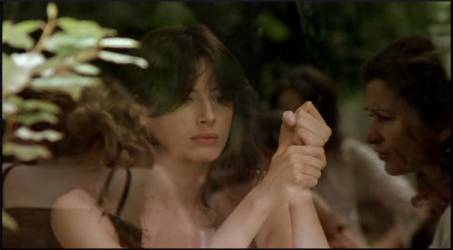
PILAR LOPEZ DE AYALA
A hunt for love and beauty?
"He" (Xavier Lafitte) is a long-haired, poetic-looking young man. In the opening shot he sits on his bed in a small hotel in Strasbourg staring into space. It's a long take; he barely moves, signaling the style of this film: abstract, meditative, visual. "She" (Pilar López de Ayala) is, he thinks, Sylvie, a young woman he met six years ago. The film's 84 minutes are divided into three "nights." "He" sits for a long time at cafés, watching the woman. It's summer, and the women are beautiful. At times he seems about to speak, but he doesn't. Finally after a second, longer sit at a very busy café near the conservatory, where women are playing stringed instruments, as he sketches in his notebook, he spots "her." And eventually he gets up to follow her when she leaves. Trying to hide that he's stalking her, he dodges behind corners. At one point he loses her. He waits a long time when she's indoors, then takes up the chase again. Once he comes close to her and says "Sylvie"? But she doesn't hear or doesn't respond.
On a streetcar, he finally summons up the courage to have a conversation with her. Politely, she tells him that she is not Sylvie. She has only been in town for a year. "A disaster," she says. "A disaster," he says too. "It's not nice to follow someone," she says. She reveals that she knew, and tried to shake him off, and it went on for hours, and was very unpleasant for her. He apologizes profusely. Then she tells him her stop is coming, and she hopes he won't get off. Of course not, he says.
Sadness in his face.
A noisy bar in the evening reveals him sitting next to another pretty, brown-haired young woman. He says things, poetic things no doubt, into her hair. Then she gets up and dances with another man. Is she more interested in him? But "the third night" reveals her beside the protagonist in bed.
His next day he sits till dusk at a bus stop, again watching people.
Guerin, who has won prizes for his films, especially his 2001 documentary Under Construction (and Sylvia was nominated for the Golden Lion at Venice this year), is a masterful people-watcher. In the City of Sylvia is beautifully shot, and makes superb use of the chance (and sometimes perhaps imposed) symbolism of street graffiti and ordinary people going about their daily takes. Strasbourg itself is the real subject of this film: in summer, it's open, airy, peaceful, lovely.Another subject is the hunt for love. Is "he" shy and hopelessly romantic? Or is his search for "Sylvie" just an excuse, a sham--or a scam? We have to decide by ourselves. The film is open-ended. You project yourself into it. For me it brought back some very familiar emotions of that time in my own life.
Shown as an official selection of the 2007 New York Film Festival at Lincoln Center.
Last edited by Chris Knipp; 08-08-2014 at 08:26 PM.
-
Aleksandr sokurov: Alexandra (2007)
ALEKSANDR SOKUROV: ALEXANDRA (2007)
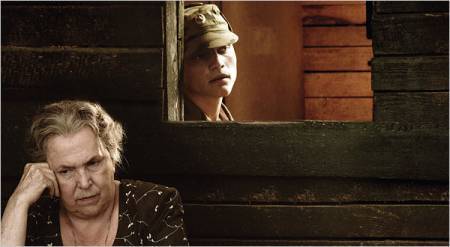
GALINA VISHNEVSKAYA
Another deep meditation from the Russian master
Shot in and around Grozny in a characteristic lightened brownish monochrome by cinematographer Alexander Burov (of Father and Son), this new addition to the Russian's studies of family relationships uses the spectacle of a powerful old woman (Galina Vishnevskaya,) visiting her grandson at an army camp near the Chechnan front as an opportunity to ponder youth and age, family hierarchies, and the motivations and aftereffects of war.
These are themes that emerge, but Sokurov's hypnotic intensity of focus keeps the action specific. There are no great events. The film depicts soldiers at the front during a long war, but there are no shots fired, no corpses, no violence among the soldiers. Alexandra Nikolaevich (her name parallels the director's) has a will of her own. Her manner is commanding but not aggressive; there is no preening about her, only a quiet dignity. She can't sleep, and wanders around on her own, casting off minders, talking to her grandson, to the sometimes ridiculously young soldiers. At first she gets into a tank. She handles and pulls the trigger of a kalashnikov her grandson shows her. She is bothered by the smells: the place is 100 degrees in the daytime. It seems Alexandra is in a place where one can walk back and forth between "enemies," and the next day she goes outside the camp to a nearby market where Chechnans sell to the soldiers. A woman who speaks good Russian (she says she was a schoolteacher) invites Alexandra to her apartment (all the buildings are battered: it could be Bosnia; it could be Beirut) and gives her tea. A young Caucasian man who takes her back to the checkpoint says, "why don't you let us be free?" "If only it was that simple," she answers.
Sokurov's last film was about the great cellist and conductor Mstislav Rostropovich and his wife, this same Vishnevskaya, a legendary opera singer. It was Rostropovich who persuaded Sokurov to work in opera (on a production of Boris Godunov). This new film was entirely inspired by Visnevskaya.
"[Alexandra]," Sokurov has said in an interview, "is a film about the ability of people to understand each other, about all that is best in a person. It is about people and the fact that the main thing for people is other people and that there are no greater values than kindness, understanding and human warmth. As long as a person lives, there is always a chance to correct mistakes and become a better person."
The film moves slowly and ends when Denis (Vasily Shevtsov), the grandson, a captain, and a good soldier, has to go off on a five-day mission, and she's taken back to the train to return home.
The power of Alexandra grows out of its basic setup: Vishnevskaya's dignity and authority are a match for a whole army camp. She is, of course, in a sense Mother Russia, and these are her children. Sokurov protests that this film is in no sense political, and I think we should respect that intention and not read pro-Russian or anti-war or other political or occasional messages into it. In the same way, The Sun is hardly a statement about Japan's monarchy or about World War II. Sokurov, a deliberately difficult and independent auteur capable of masterpieces, asks his viewer to observe and ponder, not to draw quick conclusions. It's true; sometimes his soul is so big we float around in his films a little lost. But not with Alexandra, with her sore legs, her shawl, and her long plaited hair. Her feet are on the ground. Alexandra is calming and sobering, and gives hope.
Last edited by Chris Knipp; 08-08-2014 at 08:30 PM.
-
Catherine breillat: The last mistress (2007)
CATHERINE BREILLAT: THE LAST MISTRESS (2007)
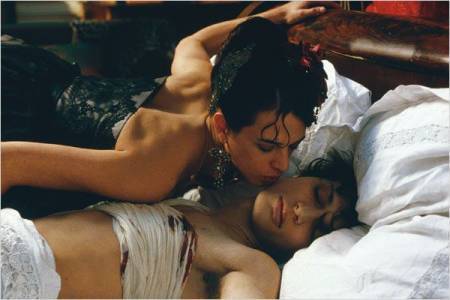
ASIA ARGENTO, FU'AD AIT AATOU
Twisting conventions in high style
Breillat's films are mostly small budget contemporary provocations with a feminist bent. This one, her twelfth, she says cost as much as ten previous ones and is a costume drama based on a controversial novel by Jules-Amédée Barbey d'Aurevilly (1808-1889). This is a bit confusing: the film begins by saying it's the century of Choderlos de Laclos (author of Dangerous Liaisons). but his famous work was written in 1782, and the action of d'Aurevilly's novel is set in 1835. The point is, the story is about the French aristocracy, and in the early nineteenth century its members still believed in and lived by the libertinism of Laclos.
In fact The Last Mistress (Une vieille maitresse) is a transitional story that links the two centuries and in a sense presents a romantic conception of the eighteenth century. Ryno de Marigny (beautiful newcomer Fu'ad Ait Aattou) is a high born young man who has squandered his wealth on his Spanish mistress, the willful Vellini (Asia Argento, in her element), with whom he's been involved for ten years. Allocine calls Ryno "a kind of romantic Valmont." But that's just it: there was nothing romantic about de Laclos' cruel and manipulative Valmont and Ryno is a new post-eighteenth-century conception of the eighteenth-century libertine that is titillated by his freedom but adds the emotional dressing of romantic passion. Breillat obviously loves this combination, is at home with it, and has given it deliriously appropriate treatment in this minor but beautiful, lush, and thoroughly enjoyable film.
The Breillat touch is perhaps most visible in the love-making scenes between Vellini and Ryno, in which there is much nudity and specificity of physical detail. Fu'ad Ait Aattou has pale skin and bigger lips than Asia Argento. By intention, both are androgynous; this is Breillat's conception of Choderlos de Laclos's and d'Aurevilly's libertines. The two actors are perfectly matched for this. Vellini is the aggressor; it is she who makes love with Ryno, using him like a lovely male statue made of alabaster. He is passionate like a romantic lover, however: that is, he's hung up on her forever, no matter what he tries. Early on, he fights a duel with her English husband and is wounded in the shoulder. The sex sequences are specific and fleshy as in no other costume drama, but Breillat is not creating an anachronistic work. As she explained in the NYFF press Q&A, she is passionate about the quality of her period detail and bought tons of lush materials and costumes. The dress, the jewelry, and the interiors are all completely authentic, and there is a rich color scheme in which red and green and yellow predominate. Without seeming over-glossy (it's not eye-candy like Sofia Coppola's Marie Antoinette), The Last Mistress is a pleasure to look at. It's also a pleasure to listen to, with its choice use of ornate and witty language. Oldtimer Michael Lonsdale as the gossipy Le vicomte de Prony particularly relishes his well-turned phrases.
As the story gets under way, Ryno has now found a wife, the beautiful young blonde noblewoman Hermangarde (Breillat regular Roxane Mesquida), and he's in love with her, and tired of Villini. Hermangarde's grandmother, the Marquise de Flers (non-actress Claude Sarraute, daughter of novelist Nathalie) is responsible for vetting Ryno, and in a lengthy sequence that's the heart of the film, he confesses to her everything about his relationship with Vellini. After much has been told (and shown on screen) in an amusing moment we see the Marquise reclining low in her seat: she is exhausted, but entranced. She wants to hear every detail. The Marquise is of course, of the older generation--a real Choderlos de Laclos lady. For her, the information that Ryno is a true libertine is proof that he is reliable, not an unknown quantity. And the cards are on the table. He'll do.
Rybno has every intention of having done with Vellini, and in a scene we've observed before his confession, he's made love with her one last time and they've said their adieus and adioses. Afrter his marriage, which we don't see, Ryno and Hermangarde live in a castle by the sea--so that he can avoid the temptations of Paris. Velllini waits four months, and then she appears. And once she is in front of Ryno, despite his professions of being fed up with her, he can't resist her.
There are several scenes in which Vellini draws blood from Ryno and licks it up: hints or Ms. Argento's father's films?
Part of the New York Film Festival 2007. Three years after a stroke, Breillat is clearly in fine form--never better--and this is a long-awaited (by her) labor of love.
Last edited by Chris Knipp; 08-25-2014 at 11:04 PM.
-
Noah baumbach: Margot at the wedding (2007)
NOAH BAUMBACH: MARGOT AT THE WEDDING

Neurotic chaos in the Hamptons
Baumbach was nominated for an Oscar for Best Screenplay for his amusing, spot-on study of a New York literary intellectual family in crisis, The Squid and the Whale. As befits one who received accolades and some little box office success, he has moved forward with similar themes and a better budget, and was able to enlist not only better known actors but a famous cinematographer, Harris Savides, and a renowned costume designer, Ann Roth. Baumbach has also moved along in time, as it were. If The Squid and the Whale was a parental breakup arguably considered from the viewpoint of a teenage boy, this family analysis has more of an adult sibling focus--though there's a boy on hand who's important. More limited in its time-span than Squid, Margot is more complex in its specifics and its conversational delineation of neurotics at play. Just about every scene is a relationship meltdown. It's a wonder nobody comes to violence. In fact one character does get kicked in the chest, and a big tree falls down doing some damage.
Baumbach himself may understand what all this is about, but the choppily edited and shot piece has too little dramatic structure (despite being very much like a play) to go anywhere or make much overall sense. Despite good buzz from some quarters and urban (especially New York) fans, the young director may lose with Margot a sizable slice of the credibility he gained with Squid.
Pauline (Baumbach's wife, Jennifer Jason Leigh), who lives on the family house on an island, is about to be married, for the second time, to out of work artist Malcolm (Jack Black). Her sister Margot (Nicole Kidman) comes with her young adolescent son Claude (Zane Pais). Ingrid (Flora Cross), Pauline's daughter, is there, and a playmate for Claude. Margot is a well-known short-story writer, and it turns out she's scheduled for a reading at a local bookstore with a former flame, Dick (Ciaran Hinds), whom she seems to want to get together with again. Dick's sexy daughter Maisy (Halley Feiffer) is also on hand. Margot has told her husband Jim (John Turturro) not come for the wedding.
Pauline and Margot haven't been getting on well for years, but they approach this occasion with the misguided assumption that they're still nonetheless each other's best friends and that things are going to be rich and consoling.
But as soon as the good-looking and accomplished, if thoroughly neurotic Margot lays eyes on the fat layabout Malcolm, she goes to work on Pauline to cancel the wedding--even though Pauline reveals she's pregnant. There is a family of nasty neighbors, the Voglers, who want the big tree in the backyard to come down. Its roots are spreading to their property, it's rotting, and it's poisoning their plants, they say.
Margot wants Claude to become more independent, but neither of them is ready for that yet. Nobody seems to be ready for anything, relationship-wise. This is about the only thing that clearly emerges.
One of the problems is in the conception of the main characters. This is not the anguished, edgy Leigh we've often seen in the past but a mellow woman, and despite lack of accomplishment and temper tantrums (which he credibly argues are justified in this crazy situation) Malcolm may have been a sweet guy who clicks very well with Pauline. Margot seems to make trouble for everybody, beginning wit her son. But since she's the most accomplished family member, it's a bit hard to know how to take her. Complex characters are fine, but nobody in this piece is going in a consistent direction. And this is equally true of the action. Was the wedding meant to have a meltdown before it ever happened?
This is a slice of life in more ways than one. Scenes are constantly cut off and linked to the next by jump cuts, an effect meant to be verite and sophisticated that tends at times merely to look sloppy. Though Baumbach says he got exactly the look he wanted, it's suprising that the Savides of Elephant and Zodiac would give us so many shots that are seriously underlit. Again, the effect hovers between original and amateurish.
All this is a shame, because all the actors do great work. The young newcomer who plays Margot's son Claude, Zane Pais, is indeed miraculously natural and believable. Leigh and Kidman do some of their best work, and Jack Black has perfect pitch in every line. There's no doubt that weeks of careful rehearsals on the set, in the house, helped the cast work so well together, and Baumbach knew what he wanted. But it reads as a series of vignettes rather than a film.
An official selection of the New York Film Festival, October 2007. Present at the press Q&A: Baumbach, Leigh, Kidman, Turturo. Moderator: J. Hoberman.
Last edited by Chris Knipp; 08-08-2014 at 08:35 PM.
-
Ethan, joel cohn: No country for old men (2007)
ETHAN, JOEL COHN: NO COUNTRY FOR OLD MEN (2007)
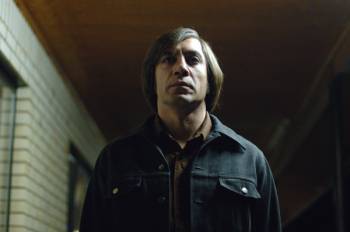
JAVIER BARDEM AS ANTON CHIGURH
Grim reaper in a Dutchboy bob
Cormac McCarthy's characteristically dry, laconic, and sometimes hilarious dialogue brightens the scenes of this superb and chilling thriller the Coen brothers have ably transferred to the screen with excellent help from Javier Bardem, Tommy Lee Tones, Josh Brolin, Woody Harrelson, Kelly Macdonald, and others, including a salty second layer of minor characters who look like they sprang straight out of the sandy soil of West Texas.
McCarthy, unmistakably one of America's greatest living writers of fiction, lives vividly in this, the Coens' first literary adaptation. Some of his best novels, notably Blood Meridian (called by Yale critic Harold Bloom one of the 20th century's greatest novels), are so apocalyptic, so embedded in their glorious poetic prose, as to be virtually unfilmable. All the Pretty Horses, from his Border Trilogy, has been filmed with some success (Matt Damon works in his role; Penelope Cruz doesn't). No Country for Old Men is late McCarthy. Post-apocalyptic, maybe. Jones's disenchanted, aging sheriff says, "When you don't hear sir and ma'am any more pretty much everything else goes." Llewelyn Moss (Brolin), a fairly innocent but opportunistic man, is deer hunting (he's not a good shot; he can't catch one out of a whole herd of them) when he finds a sprawl of wrecked vehicles and corpses, including Mexicans and a dog. There's a truckload of heroin in plastic packages and a briefcase containing two million plus in $100 bills. Moss takes the money and hightails it in his truck.
Naturally there are people who want the money back. Not nice people.
The man they hire to go after it is called Anton Chigurh. Expertly played by Javier Bardem, he's a villain--but with a clear-cut morality all his own--who's invincible and probably unforgettable. Chigurh is like the Grim Reaper: he can decide your fate with the flip of a coin; he reflects the biblical side of Cormac McCarthy, but in a terrible modern corruption. The crooks also hire another hit man, Carson Wells (Woody Harrelson)--a mistake, because Chigurh resents the duplication. he is the last word, the anti-Christ. No man may come after him.
Out in these open spaces of West Texas--El Paso, the Mexican border--where Cormac McCarthy's innocent, pure-hearted cowboys used to roam in earlier decades, things have changed beyond recognition. This is 1977. It's a few years since the Vietnam war ended. Lots of drugs and lots of money floating around; you don't hear sir and ma'am any more.
The story turns into a chase, Chgurh after Llewelyn Moss, the sheriff coming after them. And then Carson Wells, bright-eyed, bushy-tailed, and doomed, pops in to follow.
People have been talking about Bardem's pageboy haircut. Yes, it's creepy. Bardem makes Chigurh both threatening and inscrutable. It seems he'd as soon kill you as look at you. He has a long rifle with a silencer and a high-pressure cattle-killer device with a tank that looks like something a person with emphysema would carry around. It kills instantly with a pop in the head. He also uses it to shoot out door locks.
The film is more tense and suspenseful in the first half or so than in the grimly determined finale (all true to the book, if with a few details cut). By that time a lot of people have been killed and some wounded. This has some elements of the Coen's Fargo and Blood Simple (the latter introduced in an earlier NYFF) and thus with their most powerful work. But No Country is an economical and faithful literary adaptation. Some Coen movies have been thin and frivolous lately. This is emphatically not, sure and riveting from the first few shots. Richard Deakins' photography, making much appropriate use of wide-angle lenses, is superb. Their distinguished source seems to have kept the Coens honest and serious (except for the dry humor built into McCarthy's talk). Unquestionably this will wind up being one of the best American films of the year. It's tight and vivid and suspenseful. It's great stuff. The images sing and stun. There's no distracting music, only the beauty and terror of real sounds.
Present for the Nyff press screening Q&A (moderator Lisa Schwartzbaum): Brolin, Jones, Macdonald, Bardem, and the brothers Coen, Ethan and Joel.
Last edited by Chris Knipp; 11-06-2022 at 09:59 PM.
-
John landis: Mr. Warmth: The don rickles project (2007)
JOHN LANDIS: MR. WARMTH: THE DON RICKLES PROJECT (2007)
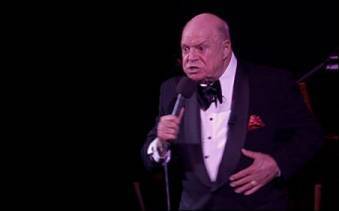
DON RICKLES
Portrait of a showbiz icon
Obviously it is very hard to be a stand-up comic. It requires good material, immense courage, and perfect timing. The ability to improvise may be very important. John Landis says Don Rickles, who is now 81 but still performing with amazing vigor, is not a comic but a performance artist. In fact, he does not tell jokes. He also does not use prepared material. He is a Jewish comic, though. He identifies himself as Jewish. He uses his schtick--he insults people--and he works with what comes up. National origin, weight, looks, a bad hairpiece, anything is fair game. Why do people love it?
This is what veteran filmmaker (Animal House, The Blues Brothers; Michael Jackson's Thriller) John Landis aims to tell us.He isn't looking for flaws, secret sorrows, bad relationships. He has told the press Rickles hasn't any of those. Landis has been a friend and admirer of Rickles for decades; he was an eighteen-year-old gofer on the set of Kelly's Heroes in the Seventies when he first met the man. (Rickles has been in a lot of movies and TV shows and the film documents that.) This is an affectionate portrait. And it works. It's impossible to walk away from it without liking Rickles and wearing a smile.
Some of the speakers: Debbie Reynolds, Chris Rock, Martin Scosese, Joan Rivers, Clint Eastwood, Robert De Niro, Robin Williams, Whoopi Goldberg, Sidney Poitier, Ernest Borgnine (he and Rickles played The Odd Couple on Broadway), Roseanne, Bob Newhart, Carl Reiner, and many others--all admirers.
There are segments of a 2006 Las Vegas performance, and it is this, of course, that best shows what Rickles does and how good he is at it, but this is not a concert film. It's the story of the working life and an affectionate portrait of a man who, it seems, has practiced his trade of being "the king of insults" for 48 years and yet made no enemies?
How has he done that? The simplest answer is, Because he's good. He pulls out the worst cliches: a man says he's German and he goose-steps on stage. He makes you laugh in spite of yourself. In the end you may realize it's really good-natured stuff. It clears the air. Joan Rivers, Landis has said (Aaron Hills retells the story in the Village Voice) once recounted how a Florida judge came backstage where they were both performing and invited Rickles to play golf with him and Rickles replied, "Listen: One, I'm leaving town. Two, you're a putz. You're loud, obnoxious, incredibly boring, and I wouldn't play golf with you because I don't live here and you couldn't fix a ticket. No." But, Landis says, Hills left out the most important part: the judge loved it. He laughed uproariously.
Such an exchange makes one--it made the judge--into a figment of the imagination, the wild imagination--of a very funny man. It is an honor to be insulted by such a comic genius. Rickles has the good material, the immense courage, and the perfect timing. And they have never left him.
He also has been married for thirty years, has two sons, and is loved. He is, Landis said, in a long monologue at the NYFF press Q&A, a great "schmearer" (Yiddish term for tipping): everywhere he goes he passes out bills so when he comes back, he's more than welcome. But this isn't a payoff; it's niceness.
The film also shows some clips of Dean Martin roasts. Rickles obviously is the king of the roast--a gathering, among friends, where someone is honored by being affectionately insulted by everyone. The insults show they're friends. In a sense, by insulting his audiences at shows in big rooms at Vegas or Miami or Indian casinos, he's showing them they're friends; he's establishing trust. Otherwise, obviously, it would just be ugly.
One of the side benefits of the film is its portrait of Las Vegas. Extraordinarly, all the entertainers who performed when the town was run by the mafia are nostalgic for those days--when, they say, everyone was treated very well.
John Landis was very entertaining at the New York Film Festival press Q&A. He loves this subject. This is a very good-looking, neatly edited film. It will be shown on HBO. The film's worth watching, particularly if you're interested in American showbiz personalities. Again, the NYFF is not a venue for great documentaries. Mr. Warmth: The Don Rickles Project is not a milestone in the art of documentary.
Last edited by Chris Knipp; 08-08-2014 at 08:42 PM.
-
Valeria bruni tedeschi: Actresses (2007)
VALERIA BRUNI TEDESCHI: ACTRESSES (2007)
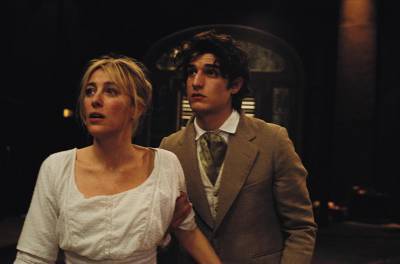
VALERIA BRUNI TEDESCHI, LOUIS GARREL
Failed productions
Valeria is valiant in this, her second directorial effort. She has tried to represent a person who may be embarrassingly like herself: an actress of stage and screen with serious self doubts, unmarried on the cusp of forty, childless and pushing the limits of her biological clock, starring in a play she can't get the hang of (one from which the actress in real life was fired). She has enlisted a highly qualified cast including her pal and collaborator Noémie Lvovsky (coauthor here), Matthieu Amalric, Louis Garrel, her own mother, Marysa Borini (as her mother), and Louis Garrel's rather awesome grandfather, Maurice. Unfortunately, the whole effort is a bust, not only the play-within-the-movie, but the movie itself. Somehow Bruni Tedeschi manages to make her role and the film at the same time both heavy-handed and vague.
Marcelline (Bruni Tedeschi) wants to have a child and prays constantly to the Virgin Mary for help. She might try finding a boyfriend. Instead she's pursued by her annoying, naggy mother (who natters on in Italian to a friend--these scenes mildly comic, but also rather superfluous), and shows such self-doubt in approaching a play she's to star in, Turgenev's A Month in the Country, that she can't even say whether she's left-handed or right-handed when pressed by the annoying director, Denis (Amalric). People say he's gay: why then does he practically try to rape her when she has one of her frequent neurotic fits--this time over the color of a dress--and try to walk out of the role? Amalric is a remarkable, very often compulsively watchable, actor. But he can bug you sometimes, and his mixture of belligerence and craziness this time only makes him one more French cinematic theatrical cliché. Where is Jacque Rivette when we need him? He'd have had a light touch, probably expanded the role of the play and made it a fascinating counterpoint to the other action. Here, that possibility of subtle parallels is only gestured at, the same bits from the play being repeated over and over. Eventually after rehearsals and the opening, Marcelline does walk off just as a performance is supposed to begin. By then it's too late. The screenplay is chronologically misconceived.
Éric (Louis Garrel), who plays the young tutor, Belyaev, who Marcelline's character falls in love with in the play, falls in love with her for real. Young Garrel has fun with his small role, managing his usual sultriness effortlessly and subtle about his declarations. But they're wasted on Marcelline. Or is it just bad luck that she thinks Éric's gotten involved with a younger woman at the end? Maurice Garrel, who's usually cast as a dead or dying man these days, appears, briefly, as Marcelline's dead father. There's another dead person, or rather a person who never lived: Natalia Petrovna, the character Marcelline is playing, as represented by Valeria Golino. It's hard to see how any of this business fits in, because everything has started off on the wrong track.
Noémie Lvovsky and Valeria Bruni Tedeschi make an odd contrast, certainly not one that is to the benefit of Bruni Tedeschi.The thing is, Bruni Tedeschi does come through as wooden, just as the characters tell her she is ("a Swiss lake" a former lover called her), and Lvovsky has an appealing funkiness, a slight comic edge to her. Lvovsky's character, Nathalie, Marcelline's former acting school classmate and Denis' collaborator in putting on the play, is the one who takes over the lead role when Marcelline walks away from it. Nathalie is unfulfilled professionally, perhaps matrimonially, but she does have a husband and young kids. Then one day she announces she's madly in love with Denis. That's when we're told he's gay. She doesn't care. Neither do we. But what we do care about is that Lvovsky is soulful and appealing. She makes us wonder why Bruni Tedeschi should be at the center of the film--which gravitates to Lvovsky every time she's on screen.
There's something going on with swimming and music, with some pretentious uses of The Marriage of Figaro and some rather peppy use of big band swing--and through it all somehow, exactly how it's hard to say, the hint that a suicide attempt may actually be a new beginning. But that's the end of the movie--a freeze-frame in mid-breaststroke.
The thing is, Bruni Tedeschi does come through as wooden, just as the characters tell her she is ("a Swiss lake" a former lover called her), and Lvovsky has an appealing funkiness, a slight comic edge to her.
Frankly, everything about this film feels misfired. It starts off on the wrong foot. It makes its points far too heavy-handedly. It's star/director is unappealing. You want to shake her and point to Louis Garrel and say Go girl, he wants you, get laid! What does she think the virgin Mary is going to do, provide her with a virgin birth too?
Some of the other projects Bruni Tedeschi has been associated with have not impressed much. To wit: (working backwards) Ridley Scott's 2006 A Good Year (not a good film). Nobuhiro Suwa's insufferably boring 2005 A Perfect Couple/Un couple parfait, Ducastel and Martineau's underwhelming Cote d'Azur/Crustacés et coquillages (same year). Whether or not you liked the movie (I did not) her role in Spielberg's 2005 (busy year!) Munich was minor. She is central to Ozon's pretentious, misfired 5x2 (2004). Her rather odd role in Ozon's much better Le temps qui reste is touching in its way.
Last edited by Chris Knipp; 08-08-2014 at 08:46 PM.
-
Marjane satrapi, vincent paronnaud: Persepolis (2007)
MARJANE SATRAPI, VINCENT PARONNAUD: PERSEPOLIS (2007)
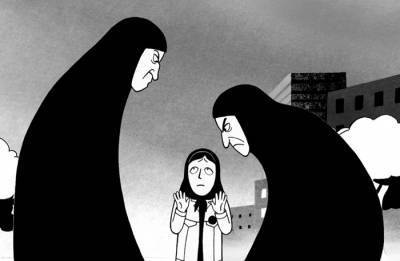
A revolutionary girlhood from graphic novel to animation
Satrapi's by now quite famous four-volume Persepolis graphic novel series (2000-2003) recounts her life to age 24, when she left Iran with her family's blessing for the last time and went to live in France (1994). Collaborating with her Paris studio-mate, cartoonist and video artist Vincent Paronnaud and a stellar French cast, she has faithfully and brilliantly transferred her books to a 95-minute black and white animated film. The French version was shown at closing night of the New York Film Festival 2007. Chiara Mastroianni is the voice for the adolescent and adult Marjane; her mother Catherine Deneuve is her mother; Danielle Darrieux her feisty, dead-honest and totally irreverent grandmother. An English-language soundtrack is under way and Sean Penn, Iggy Pop, and Gena Rowlands are aboard for it. The word on the street is that this more handmade animated film may give Pixar's Ratatouille a run for the Best Animation Oscar this year.
Persepolis has a lot going for it. It's the portrait of an unusual girlhood. Marjane grew up in a progressive ruling class family. An uncle went to Leningrad to study Marxism-Leninism. As a little girl she picked up the radicalism, and had some of her grandmother's genes for outspokenness. She soon gave up supporting the Shah and walked around the house calling for revolution. She tried on ideas constantly, posing as a prophet, then a dictator. God and Karl Marx vied for her affections. Her communist uncle was hopeful that the revolution would grow democratic; but while he was imprisoned under the Shah, he was executed under the mullahs. And of course all the girls must take the veil. Again Marji, as she's called, is obstreperous, defying the pious lies of her chador-wearing teachers. The war with Iraq causes terrible disruption: the house next door is destroyed.
For her safety in this desperate moment for the country Marji's parents send her to Vienna (1983), where she goes to the French lycée (she had been attending a French school all her life). It was a lonely and difficult time; she grows up physically (which happens in seconds in the animation--an eye-catching sequence) and has a boyfriend who turns out to be gay and another who sleeps with another girl. This rejection makes her so despondent she becomes homeless and ill and almost dies. She goes back and tries to live in Iran. This is a time when the upper class is living a double life, constantly hiding alcohol and parties and music. (Even as a child Marji bought bootleg heavy metal; she switched quickly to punk.) Attending college, she meets a man named Reza and marries him--but the union is a mistake, which her grandmother cheerfully dismisses. "The first marriage is just practice," she says. A bored, doodling psychiatrist listens to her troubles and tells her she's depressed, and gives her some pills--which seem to make her more depressed.
Eventually the time comes when Marjane is in effect ordered to leave the country for her own good. She went to France. That's the end of the books and the film.
Art Spiegelman's Pulitzer Prize-winning graphic novel Maus was an inspiration for Satrapi's work, as well as a French comics artist named David B., whose style she imitated at first. The collaboration with Paronnaud came about after they shared a studio.
The animated Persepolis has gotten rave reviews in France, and shared the Cannes festival Jury Prize with Carlos Reygadas' Silent Light.
One wonders whether Bush administration threats against Iran will arouse US audience interest in this new film, which skillfully combines a young woman's coming of age story with contemporary political history. There are no flaws, really, in Persepolis. Its use of image and voice and music is terrific.
There are some criticisms. The film adds nothing to the story line that was not in the books. Indeed it must omit a lot of the daily details some feel are what makes the graphic novels worthwhile. And when you say this is an "adult" animation, bear in mind that this is "adult" experience alright, but seen simplistically, from the point of view of a child and young adult, not a mature person. It may seem unkind to call Persepolis 'Modern Iran for Dummies,' but that's in a sense what it is. Even though the original drawing style and this animated adaptation are vivid and "graphic," and the film is able to add some more complex backgrounds and shadings not in the books, the look still remains a bare-bones, almost style-neutral one. This is not to say he film hasn't complete technical integrity. But viewers in search of a phantasmagoric visual banquet may stay away.
As noted, the closing night film of the New York Film Festival at Lincoln Center 2007. At the press screening Q&A unfortunately Mastroianni, Darieux and Deneuve could not be present, but Parannaud and Satrapi were articulate and interesting. Satrapi, who seems like such a prig sometimes as a young girl and so full of herself, in person is warm, modest, and appealing. Her excellent English will enable her to be as hands-on with the English version as she was with the French one.
Last edited by Chris Knipp; 08-08-2014 at 08:49 PM.
-
Carmen castillo: Calle santa fe (2007)
CARMEN CASTILLO: CALLE SANTA FE (2007)
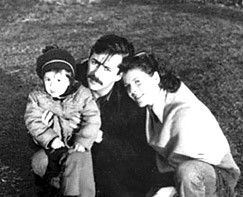
Long revolutionary memories from Chile
Carmen Castillo was the comrade and lover of Miguel Enriquez, head of the MIR (Movimiento de Izquierda Revolucionaria/Movement of the Revolutionary Left) that spearheaded the Chilean revolution that led to the election of the socialist Salvador Allende in September 1970. Most students of contemporary history know that on September 11th 1973 Pinochet's brutal military coup followed by the death of Allende, massive looting, decades of torture, imprisonment and disappearances, along with the destruction of social syndicates and organizations.
Some MIR leaders went underground, including Enriquez, Castillo, then pregnant, and two little daughters, who lived in a peaceful suburb of Santiago. Then, on October 5, 1974, police came to where they were living on Calle Santa Fe. Enriquez died. Castillo was shot and seriously wounded; later she lost the child she was carrying, but a neighbor, Manuel, called an ambulance and took her to the hospital, where she was saved.
Castillo was arrested and held after her recovery but then expelled from Chile. After drifting from country to country for a bit, she settled in France.
Resistence grew in the late Seventies and early Eighties, but MIR was dissolved of its own accord in 1985, and things have been different since the return of "democracy" in 1990.
Anyway, Castillo's long film (163 minutes) chronicles all this, with rich texture created through testimony by fellow MIR leaders who either never left or returned some time in the Eighties; through footage from the Seventies, Eighties, and Nineties; and through a chronicling of Castillo's return visits to Calle Santa Fe, where she meets people who knew her, even the man who took her to the hospital. She also revisits her family and has discussions with her father, about whom she made a 2004 documentary, Le Chili de mon père/The Chile of My Father.
One of the subjects that comes up is whether it was right for any of the leftist leaders to leave, abandoning the people they had championed to the despotism of Augusto Pinochet and his thugs. Having not only gone elsewhere but lived when MIR's leader died beside her, Castillo no doubt was troubled by survivor guilt of several kinds. Since she had not gone on with things in Chile, some of the traumas were frozen inside her.
This may not be the best way of reviewing the totality of Chile's recent history, but it's an emotionally convincing and involving way. The people in this film are impressive from many points of view--for their courage, their dignity, their language, and above all for their enduring idealism, which has never died and has been passed on to younger generations in Chile. Of course Castillo herself is obsessed. She has some letting go to do. Her campaign to have the house on Calle Santa Fe purchased and turned into some kind of study center of shrine doesn't appeal to younger leftists. Finally she is content with a small gathering when a plaque is cemented into the sidewalk in front of the house and one of the surviving leaders (nearly all of whom underwent imprisonment and torture and still have returned) says some words of poetry. There's not much humor here, but there is tremendous hope and much emotion..
Not a theatrical possibility in this country due to its length, but very worthwhile for anyone interested in leftist politics and revolution and modern Latin American history.
Shown only once at the NYFF 2007.
Last edited by Chris Knipp; 08-08-2014 at 08:55 PM.
-
Jia zhang-ke: Useless (2007)
JIA ZHANG-KE: USELESS (2007)

MA KE IN HER STUDIO
If only he had made it into a movie
American moviegoers aren't likely to know this name, Jia Zhang-ke, but he's a New York Film Festival name: his sad, haunting 2002 Ren xiao yao/Unknown Pleasures was an official selection; it's a meandering tale of two lost young men in the wasteland between industry and countryside that is a lot of modern China and it's extraordinarily original and memorable piece of work. Earlier they showed his 2000 Zhantai/Platform , which reviews the whole period of the Eighties in China and the generation that grew up then through following a traveling theatrical troupe. Recently the festival skipped Jia's 2006 Dong, about a painter, and Sanxia haoren or Still Life, from the same year, though the latter got the Golden Lion at Venice. It was Jia's 2004 Shijie/The World that first got him worldwide exposure, and was made with Chinese government approval.
Wuyong /Useless, which is the name of a new clothing line from chic Chinese designer Ma Ke, doesn't completely live up to its name, but it's a lazy piece of film-making unworthy of a director who once was the most interesting of the younger generation from his country. Without narration, it begins with a Guangdong garment factory where it indulges in some long tracking shots reminiscent of those used for a big Chinese factory in Jennifer Baichwal's Manufactured Landscapes, from last year. Workers are shown picking up lunch. Still environmentally sensible in some important ways, the Chinese shrewdly have workers bring in their own utensils and bowls. Others go to see a factory doctor for ailments.
Then the film shifts to Ma Ke talking about the meaninglessness of mass produced objects and the emotional content of clothes made painstakingly by hand. She has workers at old-fashioned looms and uses earth fabrics, even buries them in the dirt to give them the quality called in Arabic baraka, the blessedness that comes from use. That this is just another chic device--that the purchasers of Ma Ke's expensive (and now Paris-represented) couture don't know who made them any more than somebody who goes to Gap or Target does, is not a question that a narration-less documentary is likely to bring up.
Jia should be making fiction, and paying more attention.
My last NYFF screening.
Last edited by Chris Knipp; 08-08-2014 at 08:58 PM.
 Posting Permissions
Posting Permissions
- You may not post new threads
- You may not post replies
- You may not post attachments
- You may not edit your posts
-
Forum Rules





 Reply With Quote
Reply With Quote














Bookmarks